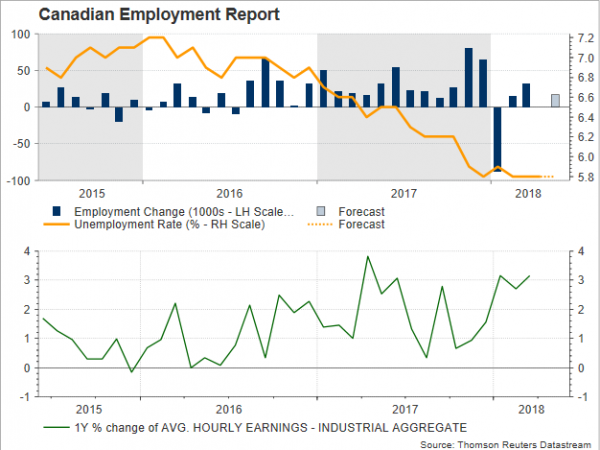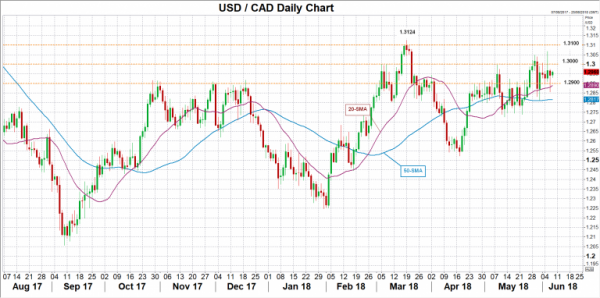The weekend after Trump decided to impose tariffs on steel and aluminum imports from Canada, Mexico, and the EU, the Bank of Canada’s Governor, Stephen Poloz, returned to his more cautious style, saying that the central bank will use its data-dependent approach to adjust monetary policy. The statement also came a couple of days after the central bank’s rate statement laid the ground for further monetary tightening this year, with investors now turning focus to upcoming employment data to verify whether July’s rate hike could ever take place.
On Friday at 1230 GMT, Canada’s employment report for the month of May is expected to show a respectful rise of 17.5k in job positions after April’s numbers indicated an unexpected a fall of 1.1k. The big miss, however, did not raise worries as the job losses were recorded in part-time positions, while full-employment continued to grow. Regarding the unemployment rate, this is projected to remain unchanged at 5.8% – the lowest level reached since 1974 – for the third consecutive time.
Given that average hourly earnings printed the strongest growth since the start of the year in March, inflation has been trending around the Bank of Canada’s midpoint price target (1-3.0%) and GDP growth picked up steam in May, an upbeat employment report would more likely increase optimism of higher interest rates in July. But with trade risks heating up on the horizon, policymakers, who meet next on July 11, will find it hard to decide whether it is time to reduce stimulus. There are fears that higher borrowing costs could harm consumption and business sentiment if US trade frictions hurt jobs in heavily indebted Canada. Last Friday, Canada, who is the top source of US steel imports, punched back with countermeasures after the US chose to activate its metal tariffs on Canadian, Mexican and EU products instead of postponing the exemption deadline beyond June 1. While this has already put NAFTA negotiations on life support, the US administration added a further challenge this week, proposing bilateral agreements to with Canada and Mexico, in a warning that a NAFTA deal is likely not going to happen ahead of the Mexican presidential elections on July 1 as well as the US mid-term elections on November 6.
Still, the loonie did not lose ground in the wake of the above news as sources stated at the same time that US Treasury Secretary, Steven Mnuchin, backed the option of exempting their Canadian counterparts from import tariffs while when communicating with the US president. The loonie hit higher instead, gaining additional speed after Wednesday’s Canadian trade stats showed a narrower trade deficit with the US, evidence that could deteriorate Trudeau’s position in Quebec, Canada, where the G7 meeting will take place on Friday. Despite the trade retaliatory game, the odds for a 25 bps rate hike by BoC in July (as indicated by overnight index swaps) also jumped on Wednesday, from around 61% to 70.37%, hinting that BoC policymakers will likely return to their hiking path next month as the last rate statement signaled. Recall that at May’s policy meeting, BoC, which has already raised rates three times since July, held rates unchanged at 1.25% but dropped the cautious wording for future potential rate rises.
Turning to Friday’s employment report, an upward surprise could add conviction that BoC will probably deliver higher borrowing costs in July, pushing dollar/loonie down to the 1.2900 round level, a previous resistance target. Below that, the 20-day simple moving average (SMA) standing currently at 1.2880 could provide support as well, while steeper declines could shift focus to the 50-day SMA at 1.2817.
On the other hand, disappointing prints could lift the pair up to the 1.3000 psychological level before the market touches Wednesday’s high of 1.3066. Then even higher, resistance could run towards the 1.3100 handle, with scope to retest the nine-month peak of 1.3124.















